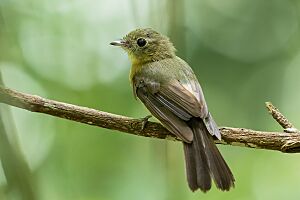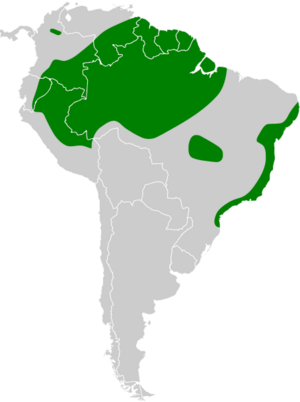Whiskered myiobius facts for kids
The whiskered myiobius or bearded flycatcher (Myiobius barbatus) is a small, interesting bird found in the warm, wet forests of South America. It's known for its unique "whiskers" around its beak, which are actually long, stiff feathers called rictal bristles. This bird is part of the Tityridae family, though some experts used to place it with the flycatchers. You can find the whiskered myiobius in countries like Brazil, Colombia, Ecuador, and Peru, living in moist lowland forests.
Quick facts for kids Whiskered myiobius |
|
|---|---|
 |
|
| Conservation status | |
| Scientific classification | |
| Genus: |
Myiobius
|
| Species: |
barbatus
|
 |
|
Contents
Understanding the Whiskered Myiobius
What's in a Name?
The whiskered myiobius got its official scientific name, Myiobius barbatus, in 1789 from a German scientist named Johann Friedrich Gmelin. The word barbatus comes from Latin and means "bearded," which perfectly describes the bird's whiskery look! Scientists use these special two-part names, called binomial nomenclature, to make sure everyone around the world knows exactly which species they are talking about.
Different Types of Whiskered Myiobius
Just like there can be different types of dogs, there are also slightly different versions of the whiskered myiobius. These are called subspecies. Scientists have identified five main subspecies of this bird, each living in a slightly different area of South America. They might have small differences in their looks or where they live.
What Does This Bird Look Like?
The whiskered myiobius is quite similar to its close relatives. It has olive-green feathers on its back and a bright yellow patch on its rump (the area just above its tail). It also has a hidden yellow patch on its head, which you might not always see. The most noticeable feature is the long, stiff feathers around its beak, which look like a basket or whiskers. Its belly is pale yellow, and the rest of its underside is greyish-olive. The tail is black and looks a bit rounded. This bird is usually quiet, but sometimes it makes a short, sharp "psik" sound.
Where Does the Whiskered Myiobius Live?
Its Home in the Rainforest
This bird lives across a large part of tropical South America, especially in the Amazon basin. You can find it in the northern half of Brazil, eastern Peru, Ecuador, Colombia, southern Venezuela, Guyana, Suriname, and French Guiana. It prefers the lower parts of the canopy in humid rainforests, usually at elevations less than 900 meters (about 2,950 feet). It likes to stay deeper inside the forest, unlike some other similar birds that might be found closer to the edges.
How Does It Live?
What It Eats
Like other myiobius birds, the whiskered myiobius mainly eats insects. It's quite good at catching them! It often flies out from a perch to snatch insects right out of the air. This is called "aerobatic" foraging.
Social Life and Habits
You might often see this bird foraging with small groups of other bird species. When it's sitting on a branch, the whiskered myiobius often lets its wings droop and fans out its tail feathers. This behavior is a bit like how Old World fantails move their tails.
Is the Whiskered Myiobius Safe?
Conservation Status
Good news! The whiskered myiobius is not currently facing any major threats. Even though it's not super common, it lives across a very wide area, and its population seems to be stable. Because of this, the International Union for Conservation of Nature (IUCN) has listed its conservation status as "least concern." This means scientists are not worried about it becoming endangered anytime soon.
Images for kids



